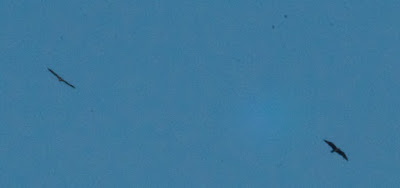One of the joys
of being a naturalist in Sarawak is the feeling that I can do more there than
simply have fun. Nature appreciation in Sarawak, despite a number of
dedicated, knowledgeable and enthusiastic people both amateur and
professional, is in many ways in its infancy. Many of its citizens live in
urban areas, and have little awareness of the wonderful natural
heritage on their doorstep. As a member of the Malaysian Nature Society (Kuching Branch), I can help to do something about that.
MNS, among other things, operates an annual awareness program called MY Garden Birdwatch. The idea is to get people to record birds in their immediate area and contribute their data to a central database, while learning (we hope) to appreciate their local birdlife in the meantime. In Kuching this has morphed (thanks to a very useful suggestion from Eileen) into a focus on schoolchildren. Each year, we pick one school, and use the upcoming Birdwatch to present its students with a series of preliminary talks and workshops on birds and birding.
In 2014, I joined Vincent Wong to meet the students at SMK Padawan, a rural school south of Kuching. I was only able to attend two sessions, on February 26 and April 3, but both times I found that the kids were both interested and eager.
After our first classroom presentation, Vincent and I took them out for a bit of binocular practice on the grounds of the school. I expected to find only a few common things - sparrows, mynahs and the like. Virtue, though, is occasionally rewarded - as I discovered when I happened to look up.
High above, I spotted a pair of raptors circling in the sky - just a pair of dots, until I raised my binoculars.
To my utter astonishment, the birds turned out to be a pair of Bat Hawks (Macheiramphus alcinus) - a first for Vincent, and a rare sighting for me. This one is a long way off, but you can see the distinctive falcon-like shape, and the white throat and vent contrasting with its otherwise black plumage.
We should probably not have been surprised. The school is not far from the limestone cliffs of the Bau region, studded with caves filled with bats, and where else should their natural predators be? However, though Bat Hawks have an enormous range (the best view I have ever had of one was in South Africa) they are far from common.
 Anyway, the day ended up being exciting for all (including Vincent, checking his photos, and myself, showing the students pictures, presumably of Bat Hawks, in our field guide). The whole thing got written up for the Borneo Post by my friend Asha Kaushal (this photo has been brazenly lifted from the Post web site) - helping to spread the word still further. So, thanks to the school, the students, the Malaysian Nature Society and everyone else involved for giving me a chance to send a message about nature to the people who will, one day, hold its fate in their hands - and, besides, to have fun in the process!
Anyway, the day ended up being exciting for all (including Vincent, checking his photos, and myself, showing the students pictures, presumably of Bat Hawks, in our field guide). The whole thing got written up for the Borneo Post by my friend Asha Kaushal (this photo has been brazenly lifted from the Post web site) - helping to spread the word still further. So, thanks to the school, the students, the Malaysian Nature Society and everyone else involved for giving me a chance to send a message about nature to the people who will, one day, hold its fate in their hands - and, besides, to have fun in the process!
High above, I spotted a pair of raptors circling in the sky - just a pair of dots, until I raised my binoculars.
To my utter astonishment, the birds turned out to be a pair of Bat Hawks (Macheiramphus alcinus) - a first for Vincent, and a rare sighting for me. This one is a long way off, but you can see the distinctive falcon-like shape, and the white throat and vent contrasting with its otherwise black plumage.
We should probably not have been surprised. The school is not far from the limestone cliffs of the Bau region, studded with caves filled with bats, and where else should their natural predators be? However, though Bat Hawks have an enormous range (the best view I have ever had of one was in South Africa) they are far from common.







nice article Ron. HOpe all is well.We're getting ready for MYGB 2016. Preparations are underway again. If you're in town feel welcome to join any of the MYGB sessions if they are running like day trips to the local public gardens-Even saw two pied hornbills on our last trip! cheers Bing
ReplyDelete